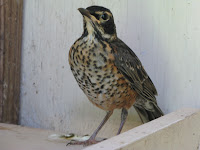The resident birds reside in large outdoor cages so that they are able to fly and have as decent of a life they can in captivity. There are also other cages outside that house adult birds that are being prepared for release. Some birds are released on the property of Giselle's (my supervisor) house while others are released at release sites found by Giselle or the biologists that she works with. For the most part, songbirds and waterfowl are released on the property and raptors are released elsewhere. There is a large pond in the backyard that wood ducks, mallards, and a one winged mute swan call home.
Inside the house, there is one room upstairs that is dedicated to the bird nursery. All of these birds are fed every half hour, hour, or every two hours depending on the age and species of the bird. We feed them a mixture we call bird burger. It includes ground beef, wheat germ, dog food, cat food, hard boiled eggs, and a few other high protein ingredients. We also add grapes and mealworms to the bird burger depending on age and species. Bird burger is made about every 10 days and is frozen until needed. When defrosted, there is also a vitamin mixture that is put into the food so the birds remain healthy.
So far during my internship I have cleaned a red tailed hawk cage after the bird was released. This was my first day and I had to first pick up the rat leftovers, clean the feces off the floor, and scrub the walls so that it was clean for the great blue heron to move in. The hawk decorated the tree that was in its cage with feces and rat parts...we were joking that it was his Christmas tree. I have also made a batch of bird burger, fed MANY baby birds (mostly robins, starlings, grackles, house finches, and a hairy woodpecker). We have three Canada goslings that constantly need to be checked to make sure they have food and water, along with 11 mallard ducklings outside that need the same. All waterfowl get a large clump of grass in their cage that volunteers pick from the yard or other cages. The red tail that was hit by a truck and is in the picture above had overgrown grass in his cage that was used for the waterfowl.
I have also unpacked the shipment of frozen rodents, cleaned the floor of the outdoor blue jay and mourning dove cage, cleaned the floor of one of the dove cages, sifted the sand in the cages to keep the sand in and the seed and droppings out, sifted the sunflowers out of the mixed seed for the doves since they do not eat sunflower seeds, cleaned out the raptor water tubs once a week in the outdoor cages, helped admit new birds, helped with a mini tour of the outdoor cages, held a mourning dove while its fractured leg was being splinted, and much more!
 So much goes on and changes from day to day that it is hard to keep up with who needs to be fed when and what needs to be done. Most of the work that is done is cleaning cages with birds or cleaning and bleaching cages for future use. Today I got the job of sifting through the mealworms that are raised here to feed the birds, picking all the dead ones out and sifting out the droppings.
So much goes on and changes from day to day that it is hard to keep up with who needs to be fed when and what needs to be done. Most of the work that is done is cleaning cages with birds or cleaning and bleaching cages for future use. Today I got the job of sifting through the mealworms that are raised here to feed the birds, picking all the dead ones out and sifting out the droppings.So far my favorite birds are the grackle and Trooper. Each bird really have an individual personality that you can't help but notice and get somewhat attached to. Talking is limited while around the birds so that they do not become imprinted. I have already learned so much from working here that I can use in the future. I started out doing basic cleaning and caring for birds and am slowly working my way up to doing more tasks (including taking fecal samples and learning to identify parasites). This is definitely going to be an interesting summer. Stay tuned!



No comments:
Post a Comment